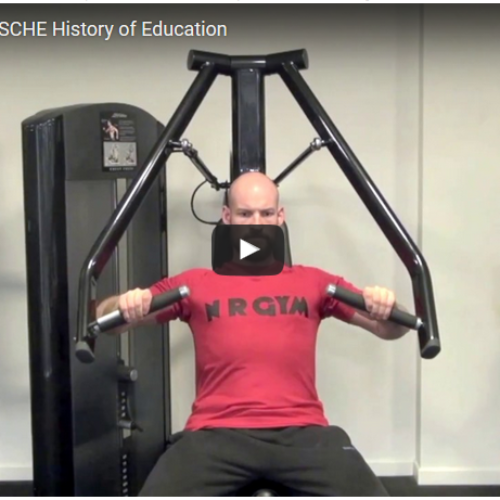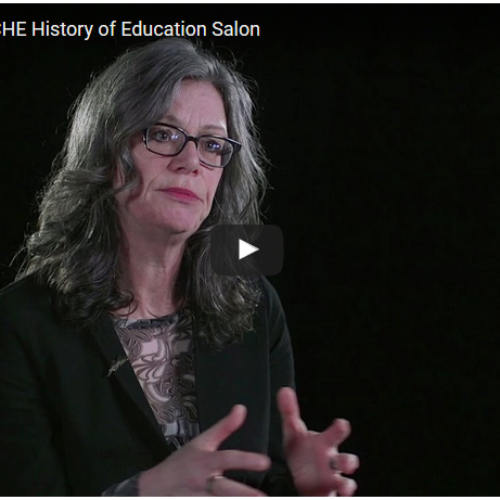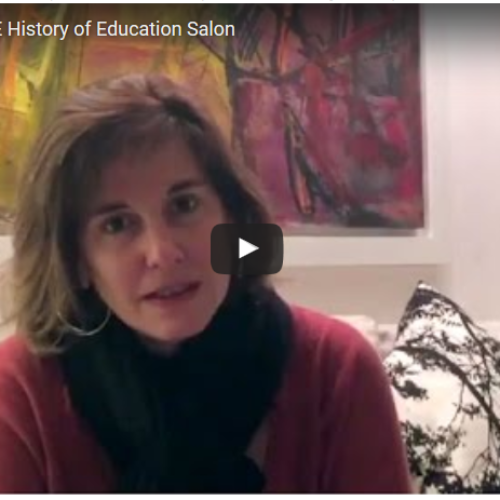le corps saisi (blog post from Rebecca Rogers)
As the organizer of this first History of education salon, I thought it might be interesting to comment on what this experience offered me, as an historian of education who hasn’t paid a great deal of attention to the body in her own scholarship. And yet, when I think back, schoolgirl bodies are present in all of my writings since my dissertation, without my making a conscious effort to think more seriously about how I could use this to offer new perspectives, explore new sources or develop new theories, as Mona Gleason urges us to do in her video.
I would like to begin though by offering my “reading of” or “listening to” these four videos (that mobilize a range of sensory experiences, as we tap on our keyboards, watch the computer screen, and listen to voices speaking in French, English and Spanish). I really love the movement I heard, from Georges Vigarello speaking about what has become such a classic text for Francophone scholars ––Le corps redressé, histoire d’un pouvoir pédagogique (1978)–– to Pieter Verstraete’s video that leads us to query our own physicality as historians of education, who spend so much time now clacking away on keyboards. I love the sweeping analytic gaze and the defense of the longue durée that Georges offers us and then the transition to Mona Gleason’s series of provocations that echo those she proposed at greater length at the outset of the ISCHE 38 conference in Chicago. For those who attended the opening ceremony in Chicago, you all undoubtedly remember how that ceremony brought all of our bodies into movement as we danced around the room to the songs and drumbeats of an American Indian welcome ceremony. So while listening to Mona reiterate the challenges that the body offers us as historians of education, I also hear those drumbeats, as well as hundreds of strands of conversations about bodies in schools, disabled bodies, the hysterical bodies of women, or the techniques of disciplining bodies. But the video also gave me the opportunity to listen repeatedly to the provocations and to ponder how I might respond in my own work.
I love as well how the salon has given voice to scholars of different generations and different national traditions, while revealing commonalities that have traversed our intellectual communities despite language barriers. While preparing my comments for Georges Vigarello, I was surprised to learn that Le corps redressé was never translated into English, although a lengthy excerpt did appear in ZONE 4, Fragments for a history of the human body, part two (ZoneBooks, 1989). Despite this, however, his arguments will probably seem familiar and surprisingly contemporary to many, despite the forty years since the publication. Still, something has changed in the way we think about the body and Inés Dussel’s video as well as Pieter Verstraete’s video drive that home in striking fashion. Inés shows us images and analyses them in ways that challenge us to think differently about photographs we often use to make our power point presentations more lively or to provoke interest from our at times somnolent students. Family archives for the past 150 years are often heavily weighted in photographs that we unconsciously interpret with our contemporary framework of reference, not realizing the analytical possibilities offered by this rich visual culture. 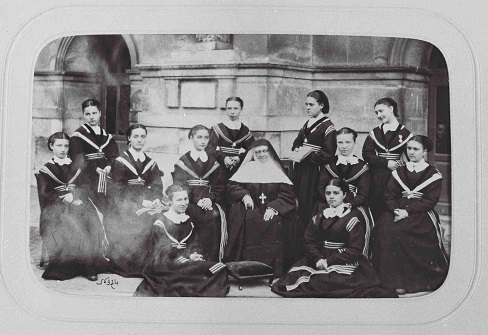 While listening and watching Inés’s video, I thought about French school uniforms, about the clothes that envelop the schoolgirls I have studied, and about photographs I have scrutinized, but with far less attention to detail. What might the readers of this blog post make of this photograph of a group of young women from a prestigious French girls’ school (Ecouen, a school of the Legion of Honor)? In my scholarship I have analyzed carefully the diary that one of these students wrote between 1875 and 1881, but I have spent far less time considering what this photo tells me about the bodily schooling experiences of both students and teachers. If you look carefully at the image, you can see the face of a teaching nun on the right hand side peering through a window, I imagine at the male photographer. Is she fascinated by the technology? Titillated by the sight of a male professional in this all-girl school? Preoccupied that this experience might provoke inappropriate thoughts from the adolescent schoolgirls arrayed before him? Or inappropriate thoughts from the photographer himself?
While listening and watching Inés’s video, I thought about French school uniforms, about the clothes that envelop the schoolgirls I have studied, and about photographs I have scrutinized, but with far less attention to detail. What might the readers of this blog post make of this photograph of a group of young women from a prestigious French girls’ school (Ecouen, a school of the Legion of Honor)? In my scholarship I have analyzed carefully the diary that one of these students wrote between 1875 and 1881, but I have spent far less time considering what this photo tells me about the bodily schooling experiences of both students and teachers. If you look carefully at the image, you can see the face of a teaching nun on the right hand side peering through a window, I imagine at the male photographer. Is she fascinated by the technology? Titillated by the sight of a male professional in this all-girl school? Preoccupied that this experience might provoke inappropriate thoughts from the adolescent schoolgirls arrayed before him? Or inappropriate thoughts from the photographer himself?
Pieter Verstraete’s video prolonged for me that feeling that I need to move back to what I thought were givens in my research, and question how the corporeal undergirds so much that I study in the past. In his video I love the fact we are abruptly pulled from the sensory environment we expect: Georges Vigarello’s beautiful study lined with 18th century books, the stark black background that frames Mona Gleason’s conversation, Inés Dussel’s comfortable sofa with all those wonderful historical documents––the “archive” we tend to fetichize…Pieter is absent from his three short videos, we hear his voice and we see contemporary bodies in action: at a gym, a woman sign reading, and a woman clacking away at her computer, a historian of education, like myself on this Wednesday morning in North Carolina. This reminds me of a comment my son made one day after school when he was about six. He described his teacher asking them to represent in physical fashion different occupations. He chose to represent an historian, his mother. He depicted me sitting up straight at a desk typing away on a keyboard while peering at a computer screen. At the time I was struck and a bit depressed that this was his image of the historian (and his mom). Naturally I didn’t expect him to imagine historians engaged in dramatic acts of bravery defending, perhaps, the principles of free speech, but this representation of my profession seemed singularly constrained and lacking the flare of 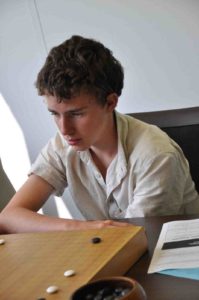 adventure. As he imitated me sitting at a desk could he imagine the excitement of discovering newly digitalized archives that opened up new vistas for my current project? Could he possibly understand that I was putting into words the accumulated knowledge of hours spent in archives thumbing through archive boxes? Or that I was describing the experience of visiting a cemetery in Algiers, encountering the remains of a life I was interested in, now a run-down tombstone with some remarkable mosaics and words engraved in stone, both in French and Arabic? At the time I assumed not. But consider this image of my son a few years later, seated at a table intently focused on a goban. Do we read this body as constrained? Disciplined? Obviously in some ways, yes, but I think we also intuit the nervous tension of the game, the excitement of possibilities, and the possible sequence of moves that he is imagining in his mind. I’d like to think he saw all that in my posture, in my concentration as I typed and read. Our bodies tell us a great deal more than we think. And this salon is an invitation to ponder what difference that makes in our scholarship.
adventure. As he imitated me sitting at a desk could he imagine the excitement of discovering newly digitalized archives that opened up new vistas for my current project? Could he possibly understand that I was putting into words the accumulated knowledge of hours spent in archives thumbing through archive boxes? Or that I was describing the experience of visiting a cemetery in Algiers, encountering the remains of a life I was interested in, now a run-down tombstone with some remarkable mosaics and words engraved in stone, both in French and Arabic? At the time I assumed not. But consider this image of my son a few years later, seated at a table intently focused on a goban. Do we read this body as constrained? Disciplined? Obviously in some ways, yes, but I think we also intuit the nervous tension of the game, the excitement of possibilities, and the possible sequence of moves that he is imagining in his mind. I’d like to think he saw all that in my posture, in my concentration as I typed and read. Our bodies tell us a great deal more than we think. And this salon is an invitation to ponder what difference that makes in our scholarship.
About author
You might also like
Pieter Verstraete “Education and the Body”
This video from Pieter Verstraete (KU Leuven, Belgium) is one of four lead off recordings in which historians discuss education and the body as part of the ISCHE April 2017
Mona Gleason “Education and the Body”
This video from Mona Gleason (University of British Columbia, Canada) is one of four lead off recordings in which historians discuss education and the body as part of the ISCHE
Inés Dussel “Education and the Body”
This video from Inés Dussel (DIE-CINVESTAV, Mexico) is one of four lead off recordings in which historians discuss education and the body as part of the ISCHE April 2017 History

